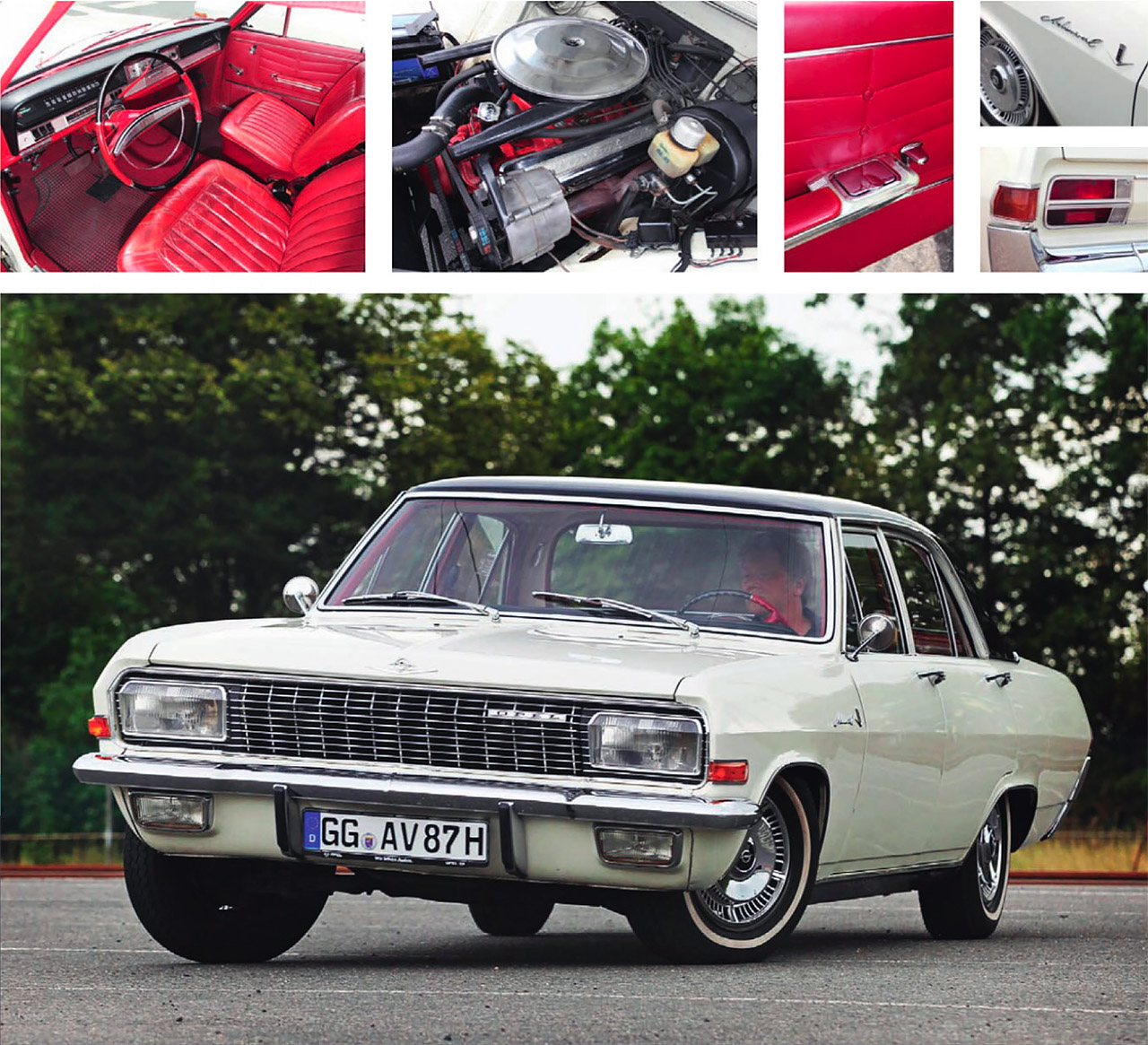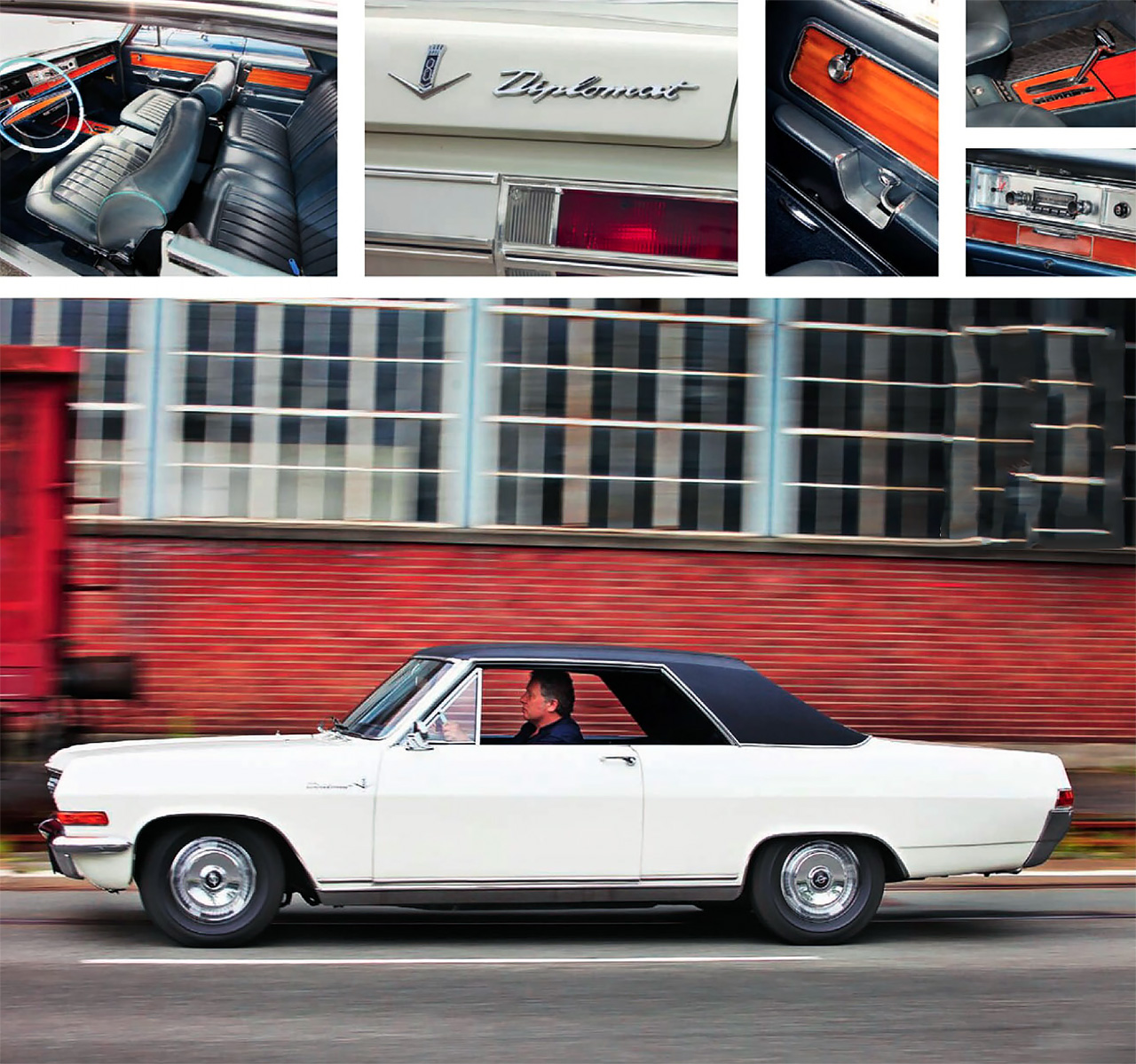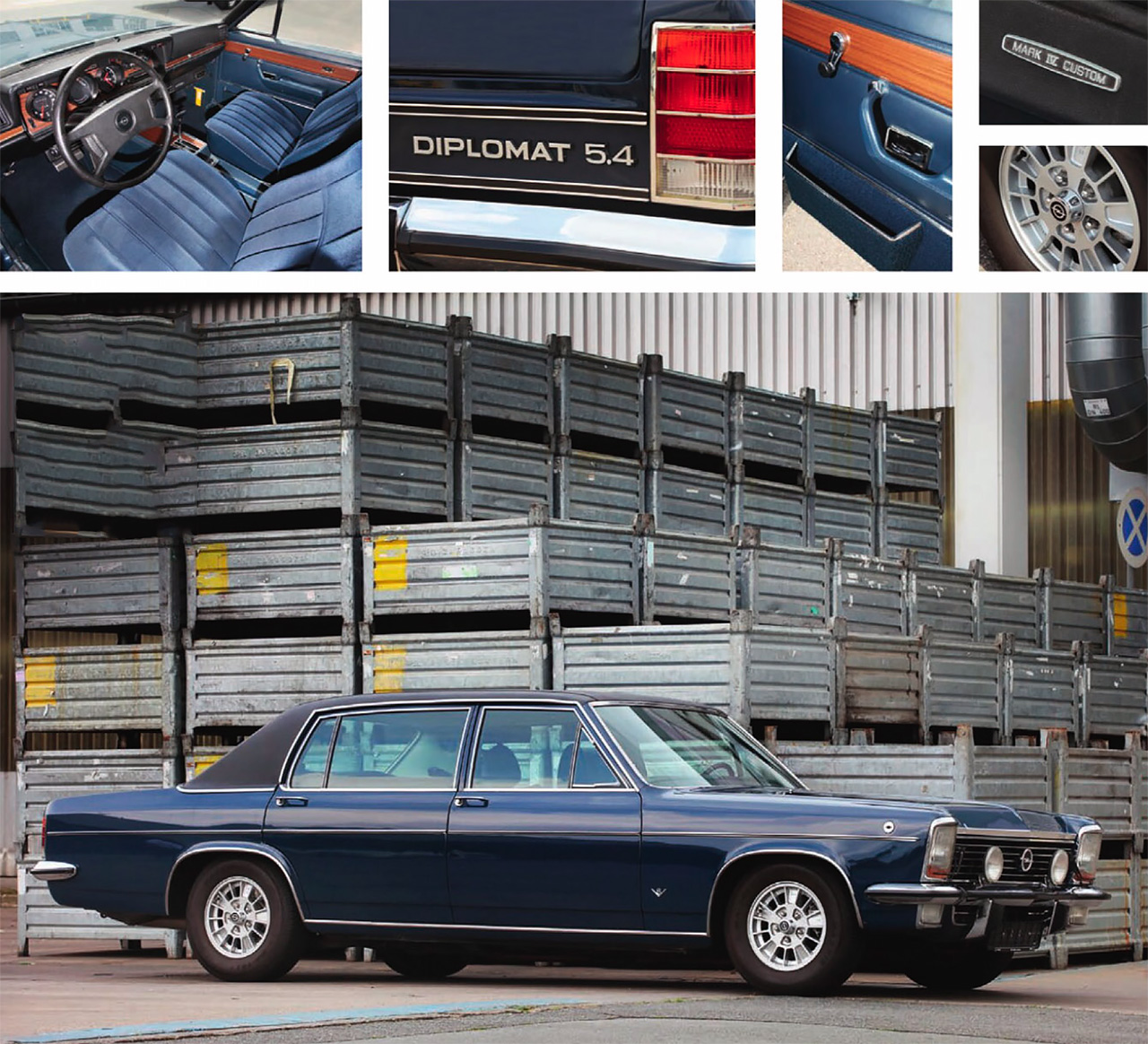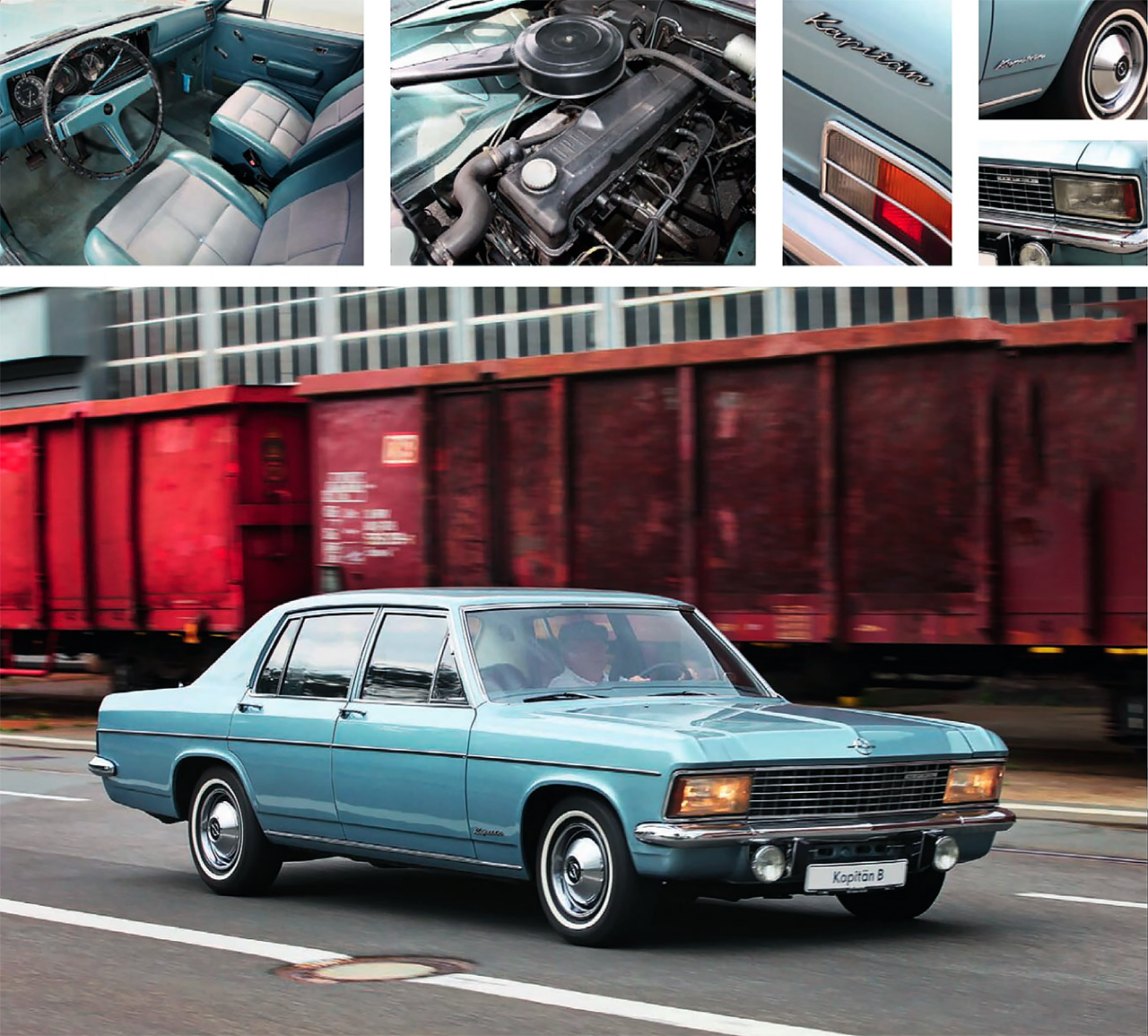
When Opel set its sights on Mercedes-Benz. Opel’s top rank. The Kapitan, Admiral and Diplomat were worthy Mercedes rivals, says Martin Buckley. Photography James Mann. During the 1960s, Opel’s long-term aim on mainland Europe was to offer a lasting, upwardly mobile one-stop shop for brand-loyal buyers – from the poverty Kadett to a Mercedes-baiting limousine – but in the UK the company’s ambitions ended with the rather impressive ‘Coke bottle’ Commodore. Which is why, to most of us, the really big Opels of the 1960s and 70s are a mystery.
For some reason, Russelsheim deemed its Kapitan, Admiral and Diplomat series not to be appealing to British tastes. More likely, it was felt politically wise not to give the superficially similar Vauxhall Cresta / Viscount any unwanted in-house GM competition. Whatever the case, none of these KAD series cars (as Opel calls them) appear to have officially come to Britain.
That always seemed a shame, although there is no evidence to suggest that the KAD series of 1964-1969 would have found any greater favour in the UK than they did elsewhere. Having said that, Opel was sufficiently optimistic to launch a ‘B’ series – with a facelifted body and de Dion rear suspension – that ran through to 1977. In both forms, the influence of these models outside of Germany was moderate. Within their domestic setting, however, they provided a surprisingly persistent irritant to those who believed that the only big German car worth having was a Mercedes. Thanks to Opels fantastic – but not widely advertised – factory museum, we were able to get to grips with both generations of Kapitan, Admiral and Diplomat, essential landmarks in any barge-lover’s education.

Clockwise, from main: Admiral’s handling isn’t as wallowy as you’d expect, asserts Buckley; red leather helps to lift basic interior; V8 was a rare option for the model; button entailing on door card; bumper integrates neatly into the rear wing.
The six-cylinder Kapitan and Admiral featured traditional Opel names that were rooted in the 1930s and 40s. In various forms, the Kapitan had maintained the company’s big- car presence throughout the ’50s, offering glitzy motoring for prices that substantially undercut any ‘sixes’ in the visually staid Mercedes range. But when Stuttgart upped its game with die new 220S and SE W111 ‘Pintail’ saloons in 1959, it began to dawn on Opel that bargain glamour might not be enough to maintain its dominance in an increasingly well-educated market.
By 1964, the need for a more modern and capable range of large Opels was pointedly demonstrated by the official January sales figures for new German registrations: Opel managed to shift just 80 units of the old, chrome-laden 90hhp Kapitan models, while Mercedes sold a whopping 1922 of the W111 220 Heckflosse.
Luckily, the new flagship Opels were only a few weeks away from launch at that year’s Geneva show, where they were warmly received. At a glance, 50 years down the line, they appear to be almost generic Euro-saloon fodder – large and impressive with handsome, internationally acceptable lines that could merge effortlessly into any cityscape, which was exactly what the firm intended. Although the clean flanks, squared glasshouse and fat C-pillars were very much in the then-current American GM idiom, the new KAD Opels were designed in-house by Clare MacKichan, who had come from Chevrolet to run Opel’s styling studio from 1962 to 1967.
Measuring more than 16ft long on a 9ft 4in wheelbase, the sheet metalwork didn’t hide anything radically new but offered carefully improved re-workings of what was known to be reliable. The rigid rear axle hung on massive leaf springs but was well-behaved enough to earn praise even from Rudolf Uhlenhaut, who – after trying out the cars at the Benz test track – admitted that he considered it to be almost die equal of Mercedes’ expensively engineered swing axles.

Clockwise, from main: American-inspired lines are accentuated on the Diplomat A Coupe; rear legroom suffered; the V8 model made use of Chevrolet power; neat interior detailing; two-speed Powerglide gearbox; period Blaupunkt.
Discs on the front and twin master cylinders gave the big cars the latest in brakes, and in their initial 2605cc six-cylinder form – reworked with self-adjusting hydraulic tappets – the 100bhp Kapitan/Admiral would top 100mph with the full-synchromesh four-speed manual. The new option of a floor centre change illustrated Opel’s eagerness to show buyers that this was not just another pseudo-American sedan.
‘OPEL WAS EAGER TO PROVE THAT THIS WAS NOT JUST A PSEUDO- AMERICAN BARGE’
The Admiral was the middle child and would prove to be die most popular with buyers. The Kapitan was the ‘economy’ model with bench front seat, manual steering and fewer of life’s comforts. In 1965, a year into production, Opel upgraded the straight-six to a more modern cam-in-head 2.8-litre design with 125bhp, its basic architecture extrapolated from the new four-cylinder Rekord B engines. The cam-in- head arrangement-with short pushrod s – allowed for lower bonnet lines without having to resort to canting the unit over, as with some of the contemporary overhead-camshaft designs.
It was the flagship V8 Diplomat that elicited the most comment, however. Apart from its standard vinyl roof, it looked much the same asthe ‘sixes’ and was offered with the clear intention of helping make a big Opel, perhaps for the first time, a car that you aspired to rather than bought because it was all you could afford.
With very little, if any, funding from its American parent to tool up for new engines, Opel had made a benefit out of a necessity and simply ordered a supply of 4.6-litre Chevrolet V8s to power this new 120mph, DM 17,000 variant. This neatly side-stepped any major investment and, to the irritation of Mercedes, instantly bestowed this low-born car with straight-line urge equal to the 600 super-limousine and conspicuously superior to the 300SE.
So irked was Mercedes that it quickly upped the power output of its injected 3-litre. It then let it be known that owners of existing models could have the latest modifications carried out free of charge at their local dealership, an indication of how seriously the Germans took the flat-out battle for autobahn supremacy.
{module Best Opel}
You could have a four-speed manual Diplomat, but even in automatic two-speed Powerglide form, these cars could accelerate to 60mph as quickly as the contemporary Porsche 911.
The idea for the Diplomat is attributed to Opel’s chief engineer Hans Mersheimer, who had already experimented with a V8 Q-car prototype for his own use. Fitted with an Oldsmobile Firebird F-85 engine, this innocent-looking 1962 Rekord coupe could reportedly do 0-60mph in 6.5 secs. Herr Mersheimer’s Porsche-slaying adventures on the autobahn in this car were gleefully reported in the German press, so perhaps the Diplomat wasn’t as unexpected a development as you might think.
Opel felt bullish enough to square-up to Mercedes with a 1965 Coupe version of the Diplomat, which was handsome, if not as elegant as Mercedes W111 two-doors. Perhaps even the market decreed that Russelsheim was getting above itself because it sold only 347 of these Karmann-bodied cars at DM 25,000 each. They came as standard with a bigger 5354cc V8 and, for a while, were about the fastest German production car you could buy, at 128mph.
Almost as rare as the Coupe were the Admirals and Kapitans fitted with the 4.6-litre V8. This option cost an additional DM 3300, which perhaps explains why just 113 Kapitans and 622 Admirals were thus equipped.
The featured Admiral V8 – complete with black vinyl roof, full red leather and a neat manual sunroof- is a Diplomat in all but name. Outwardly, the dual tailpipes are the main giveaway. On all versions, you feed the tank through a central filler above the bumper, and there is a huge boot – a welcome Americanism.
There is a Rover-like solidity to the action of the doors and the beautiful interior smell somehow jars with the metallic, horizontally themed facia with its 20-220kph ribbon speedometer and minimal minor instrumentation – confined to fuel level and engine temperature. The clock and radio are neatly integrated and could have been borrowed from a bedside tea-maker.

Clockwise, from main: Diplomat В gained vertical headlamps – note the wing mounting points for Presidential flags; sober interior; В model came with a straight-six or – as here – a 5.4-litre V8; variety of materials on door card; stylish alloys.
The driver commands the climate via left- handed heating and ventilation controls, the centre portion of the dash being occupied by the tinny lid of the glove compartment. I cannot think of another car with its glovebox in the centre of the dashboard, but it’s obviously a lot more useful for the driver.
The Diplomat Coupe – one of the most collectable of all post-war Opels – is rather more plush inside. It has real wood, deep-pile carpets that go halfway up the doors and the ultimate 1960s luxury of electric windows all round, plus a remotely adjustable outside mirror, reclining front seats and lights in the footwells.
The decadence doesn’t stop there: the Diplomat has storage bins in the doors, a lavish dark blue headlining and individual rear seats with a ‘ V8’ motif between them, just in case you forget. Although it was designed around the saloon’s wheelbase, front passengers are given priority in the Coupe, which has much less rear legroom than the saloon. Oddly, the seats are trimmed in downmarket PVC.
Naturally, there’s not much to choose between them once under way. The Admiral V8 is smooth and brisk, whereas the 5.3-litre unit in the Coupe has a discernible kick to it that can easily make the back tyres squeal.
In effect, you never feel the gears change because there are only two of them in the Power-glide, and first is only really for getting you moving. Both cars accelerate with an appropriately menacing V8 throb and, while they are not really the sort of cars that invite you to handle them aggressively, they are far from being soft and soggy. Body roll does not feel as dramatic as the photographs suggest and the power steering- by ZF from 1967 – has some resistance fed into it and even a bit of kickback. While you don’t particularly notice the low gearing, you do appreciate the tight lock.
By the time production finished in 1968, the KAD Opels had made their mark with just under 90,0 sales – although that compared poorly to more than 145,000 Kapitiins of the previous 1959-1963 generation. The cars had been gently improved along the way, with the DA 1500 option of a 140bhp twin-carburettor straight-six in the Kapitan and Admiral in 1967, and the standardisation of the bigger V8 in the Diplomat saloon in die previous year. The ‘sixes’ could have Power-glide from 1967 and you can spot a later KAD car by the rubbing strips along its flanks.
The second generation of Kapitan-Admiral- Diplomat was launched at Geneva in 1969 and would face a more sophisticated big-car landscape where ‘premium’ brands would come to dominate – no matter how good the volume manufacturer’s offerings might be – while the taste for anything in the transatlantic idiom was fading fast. Mindful of this, and of the threat posed by the new six-cylinder BMW saloons, Opel knew it had to try harder.
Expensive-to-produce de Dion rear suspension was the big news on these ‘B’ series cars, with CV-jointed driveshafts for smooth power delivery. Along with a new Bosch electronic fuel- injection option on the straight-six, these were technology firsts on any General Motors car. A modern, responsive three-speed GM ‘Strasbourg’ automatic was used across the six-cylinder range and the V8 Diplomat came with the latest three-ratio Turbo Hydramatic.
Although based on the same wheelbase, they were marginally smaller cars overall, yet somehow the slightly clunky styling conspired to make them appear bulkier than their predecessors. There was, however, more visual definition between the three models: Diplomats had Mercedes-style vertical headlamps that gave them an almost Buick Riviera-like front end, whereas Kapitans and Admirals had smaller, horizontally arranged units and no vinyl on their roofs. Diplomats had vertical tail-lights.
There would no longer be the option of a V8 Admiral or Kapitan, but it was possible to order a Diplomat ‘E’ with the straight-six fuel-injected engine, which gave it nearly as much performance as the V8. Both varieties of Diplomat had four-wheel vented disc brakes, while lesser models continued with a disc-front, drum-rear set-up appropriate for their 110mph urge.
In 1970, the Kapitan name was dropped altogether, so if you wanted a basic car you ordered an Admiral ‘N’ – less the heated rear window and power steering of the ‘Luxus’. The Admiral 2800S had the twin-carburettor, 145bhp engine, Opel having teased out a few extra horsepower by experimenting with exhausts.
Although it was available for only a year, almost 5000 of the last Kapitan variant were sold, and I thought it would be instructive to drive at least one of the ‘sixes’.
With plastic floor mats rather than carpets and big settee-like seating (covered in what the Americans called ‘brocade’) the all-blue interior of the Kapitan B feels colourful but primitive. It is a sort of taxi/travelling salesman specification and, compared to the suave power of the V8 cars, the Kapitan is a big, sweaty machine to drive, and one imagines it being driven by big, sweaty men heaving on its unassisted steering, clonking mindlessly through column gear- changes as they rouse its lusty-sounding 132bhp.
{CONTENTPOLL [“id”: 8]}
If this is perhaps the very essence of ‘barge’, with not a single option box ticked, then the long-wheelbase Diplomat V8 represents the other extreme. T he featured car was built in 1976 and used for US president Gerald Ford’s visit to Germany – you can still see the flag holders on the front wings. Opel started producing the gently stretched (by 150mm) Diplomat V8 in 1973 as a reaction to Mercedes’ new SEL models, which were wiping the floor sales-wise with the somehow prematurely aged Opels.
Nice car though the late Diplomat 5.4 is, it is not hard to see why it failed to set the sales charts alight. The big velour seats look suitably sober and ‘executive’, yet the rest of the cabin is gloomy and unappealing – not only in its fussy design but in its choice of brittle materials shared with lesser Opels. The ‘MkIV Custom’ air-conditioning unit looks like an afterthought but was doubtless appreciated by President Ford between gala dinners as he lolled on the rear seat enjoying the monstrous legroom.
‘EACH OF THESE CARS WAS ABLE TO FLASH DOWN THE AUTOBAHN FOR HOURS ON END’
It detaches you from the world more effectively, is adequately fast with a good solid punch to its mid-range kickdown, and just feels subtly more ‘together’ than its 1960s antecedents in 100 small ways. Yet, somehow it is not such a nice place to be. You sit lower, you cannot see out of it quite so commandingly and, for all its smoother de Dion-assisted ride and more positive power steering, you want to be back at the wheel of the earlier Diplomat.
Although one can sense the tension between America and Germany in the design of these big Opels, in many ways they struck an excellent compromise between the best of both worlds. Their scale and proportions satisfied those buyers who aspired to owning an American-type car, yet they had the stability of a vehicle that was expected to flash down an autobahn at something close to its maximum speed for hours on end in typically unforgiving German fashion.
In their most exalted forms, they were effortless and luxurious, but were also designed not to wobble off the road at the first sight of a corner. Although the ‘B’ series of the KAD range was not a success by Opel standards – with 60,000 built – they were respected for their engineering and useful lessons were learned from them, the main one being that Europeans preferred to buy a European-looking car. Neither was Opel dispirited by buyers’ indifference to a big car from Russelsheim that was as good as the opposition but lacked the right badge. The 1977 Senator is evidence of that.

Clockwise, from main: the updated Kapitan B was slightly smaller than its predecessor; spartan interior for entry-level model; single carb on straight-six; last hurrah for Kapitan name; revised horizontal headlamps.
| Opel |
Admiral A 4,6 |
Diplomat A Coupe |
Kapitan B 2800 | Diplomat B 5.4 |
| Made in | Germany | |||
|
Sold |
1964-1968 | 1965-1967 | 1969-1970 | 1969-1977 |
| Number built | 55,876 (all Admiral A variants) | 347 | 4976 (all) |
11,108 |
| Construction |
All steel monocoque |
|||
| Engine |
all-iron, overhead-valve, 4638cc V8. Carter carburettor |
5354cc V8 |
cam-in-head, 2784cc straight-six, Zenith carburettor | cast-iron, pushrod 5358cc V8, Rochester carburettor |
| Max power (DIN) | 187bhp @ 4600rpm | 226bhp @ 4700rpm | 132bhp @ 5200rpm | 230bhp @ 4700rpm |
| Max torque (DIN) |
255lb ft @ 3000rpm |
314lb ft @ 3000rpm | 139lb ft @ 3500rpm | 315lb ft @ 3000 rpm |
| Transmission | two-speed Powerglide automatic, RWD | four-speed manual, RWD | three-speed Powerglide automatic, RWD | |
| Suspension |
front double wishbones, coil springs rear rigid axle, semi-elliptic springs |
front double wishbones rear de Dion tube; coil springs, a-r bar f/r |
||
| Steering |
recirculating ball |
power-assisted recirculating ball | ||
| Wheels | ||||
| Brakes | discs/drums, with servo | discs all round, with servo | discs/drums, with servo | discs, with servo |
| Measurements | ||||
| Length | 16ft 3in (4953mm) | 16ft 2in (4948mm) | 16ft 1 in (4907mm) | 16ft 7in (5070mm) |
| Width | 6ft 3in (1905mm) | 6ft 3in (1902mm) | 6ft (1835mm) | 6ft 11in (1852mm) |
| Height |
4ft 11 in (1510mm) |
4ft 8in (1432mm) |
4ft 9in (1450mm) |
4ft 9in (1450mm) |
| Weight | 3593lb (1630kg) | 3593lb (1630kg) | 3725lb (1690kg) | 3791lb (1720kg) |
| 0-60mph | 11 secs | 10 secs | 12 secs | 9 secs |
| Top speed | 123mph | 124mph | 108mph | 125mph |
| Mpg | 15 | 14 | 17 | 11 |
| Price new |
DM15,950 (1964) |
DM25,000 (1965) | DM23,300 (1969) | DM21,556 (70) |
| Price now |
c£15,000 |
c£20k | £8-10,000 | £8-10,000 |





